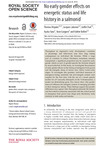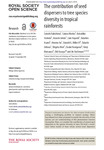Search
Now showing items 1-10 of 48
Effects of habitat structure and land use intensity on the genetic structure of the grasshopper species Chorthippus parallelus
(2014)
Land-use intensity (LUI) is assumed to impact the genetic structure of organisms. While effects of landscape structure on the genetics of local populations have frequently been analysed, potential effects of variation in ...
Discrete but variable structure of animal societies leads to the false perception of a social continuum
(2016)
Animal societies are typically divided into those in which reproduction within a group is monopolized by a single female versus those in which it is shared among multiple females. It remains controversial, however, whether ...
No early gender effects on energetic status and life history in a salmonid
(2015)
Throughout an organism’s early development, variations in physiology and behaviours may have long lasting consequences on individual life histories. While a large part of variation in critical life-history transitions ...
Tooth serration morphologies in the genus Machimosaurus from the Late Jurassic of Europe
(2014)
Machimosauruswas a large-bodied durophagous/chelonivorous genus of teleosaurid crocodylomorph that lived in shallow marine and brackish ecosystems during the Late Jurassic. Among teleosaurids, Machimosaurusand its sister ...
Omura’s whales off northwest Madagascar
(2015)
The Omura’s whale (Balaenoptera omurai)was describedas a new species in 2003 and then soon after as an ancient lineage basal to a Bryde’s/sei whale clade. Currently known only from whaling and stranding specimens primarily ...
The contribution of seed dispersers to tree species diversity in tropical rainforests
(2015)
Tropical rainforests are known for their extreme biodiversity, posing a challenging problem in tropical ecology. Many hypotheses have been proposed to explain the diversity of tree species, yet our understanding of this ...
How the zebra got its stripes
(2015)
The adaptive significance of zebra stripes has thus far eluded understanding. Many explanations have been suggested, including social cohesion, thermoregulation, predation evasion and avoidance of biting flies. Identifying ...
Highly contrasted responses of Mediterranean octocorals to climate change along a depth gradient
(2015)
Climate change has a strong impact on marine ecosystems, including temperate species. Analysing the diversity of thermotolerance levels within species along with their genetic structure enables a better understanding of ...
Dramatic niche shifts and morphological change in two insular bird species
(2015)
Colonizations of islands are often associated with rapid morphological divergence. We present two previously unrecog-nized cases of dramatic morphological change and niche shifts in connection with colonization of tropical ...
New evidence on the tool assisted hunting exhibited by chimpanzees
(2015)
For anthropologists, meat eating by primates like chimpanzees (Pan troglodytes) warrants examination given the emphasis on hunting in human evolutionary history. As referential models, apes provide insight into the evolution ...










